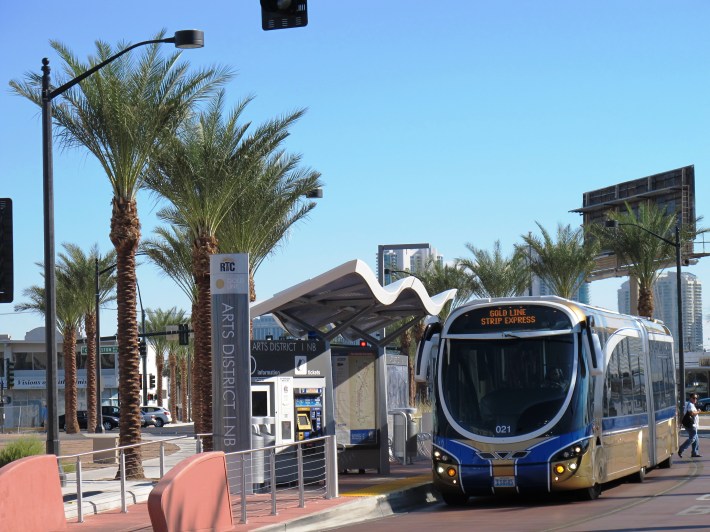Last month the Institute for Transportation and Development Policy released its report, “Recapturing Global Leadership in Bus Rapid Transit” [PDF], which proposed a LEED-like rating system for bus rapid transit projects and laid out a strategy for American cities to build systems as good as the world’s best BRT. While more than 20 American bus projects have claimed the BRT mantle at various times, the ITDP report named just five American cities with bus corridors that made the grade and earned the title “True BRT.” Streetsblog is pleased to publish a series of case studies from ITDP examining these innovative transit projects. We started with Pittsburgh and Cleveland, and today, we look at Sin City -- Las Vegas.

When you think of Las Vegas, the first thing that pops into your head is efficient transit, right? Well, maybe not the first thing. But according to ITDP’s report, Las Vegas has one of the top five BRT systems in the country.
Las Vegas is one of the few U.S. cities with a whole network of BRT, as opposed to just a single corridor. And while the Strip Downtown Express (SDX) is the most advanced BRT route in the network, the fact that the city is creating a network elevates its status among U.S. BRT systems.
The network presently includes two BRT routes (with another two under construction), along with two express bus routes that incorporate some BRT elements. The network serves both the city and nearby suburbs, and is good news for a metropolitan area that was especially hard hit by the recession.
In a sprawling region where the recession and rising gas prices hit many commuters hard, growing numbers of people are opting for fast, reliable, and affordable bus service. The BRT network, built at a fraction of the cost of other alternatives like light rail or the city's problem-plagued monorail, also appeals to savvy politicians looking to deliver both quality and value for their constituents.
Las Vegas’s Bus Rapid Transit program began with the Metropolitan Area Express (MAX), which opened in 2004. The MAX offers many standard BRT features including off-board fare collection, special buses, and stations with at-level boarding at most stops. It has 4.5 miles of dedicated lanes (out of a total route of 7.5 miles), which are aligned by the curb and shared with right-turning traffic. The MAX corridor is also shared by the Route 113 buses, which essentially serve as a “local” to the MAX’s more express service.
Public outreach and a strong marketing campaign created a receptive environment for the MAX, and the initial success of the system increased public support. Early studies reported 40 percent of riders saved at least 15 minutes with the new service, and over 60 percent were saving 10 minutes or more.
MAX’s success allowed Las Vegas to move ahead with the even more ambitious Strip Downtown Express (SDX), which has all of the elements of MAX plus a central-median, dedicated right-of-way for 2.25 miles (of a total nine-mile route). The SDX connects the Strip and Downtown and it shares its infrastructure with the Deuce, which makes more frequent stops.
The SDX has won riders over with improved service, but also with a scaled-up look and feel. “I’d say it’s a train on tires,” said Jacob Snow, general manager of the Regional Transportation Commission of Southern Nevada (RTC). The buses are quieter and sleeker than regular buses, and they stop at attractive stations, built with art and architectural features that celebrate the local landscape.
But even MAX’s success could not give the RTC enough political power to secure dedicated BRT lanes on the Strip, largely because casino owners were loathe to make it easier for guests to leave. In fact the RTC had to fight for buses to run on the Strip at all. As a result, the SDX operates in mixed traffic on the Strip, despite the fact it is one of the most congested routes in all of Las Vegas.
This year the SDX will be joined by the Boulder Highway Express, with a 15-mile route connecting Las Vegas and Henderson, and dedicated curbside lanes in downtown Las Vegas. The system will have at-level platform boarding, pre-boarding fare collection, and high-quality station design. And the RTC has already broken ground on the Sahara Express, which will also operate on a dedicated curbside lane for much of its route and connect with the Deuce on the Strip, the SDX, and the Boulder Highway Express routes. The Sahara Express is being constructed at a cost of $40 million, $34.4 million of which is covered by a U.S. DOT TIGER grant.
While some residents continue to call for light rail, the BRT system is delivering results today, saving commuters time and money, reducing traffic congestion in and around Las Vegas, and creating upwards of 500 jobs as the network expands.
Dani Simons is director of communications at the Institute for Transportation and Development Policy.
Read ITDP’s full report: Recapturing Global Leadership in Bus Rapid Transit.





